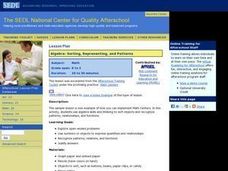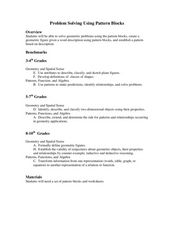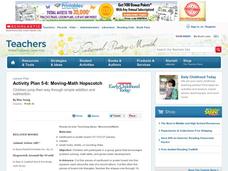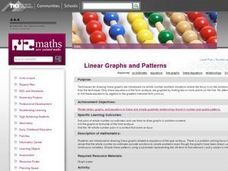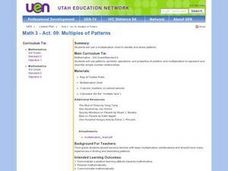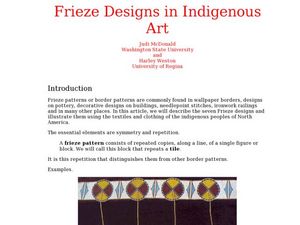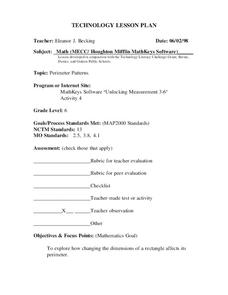Curated OER
Algebra: Sorting, Representing, and Patterns
Students sort objects and create patterns. In this sorting and graphing activity, students work at centers to find a way to sort a group of objects, then make a graphical representation of the number of each item. Finally, students...
Curated OER
Matchstick Patterns
Third graders investigate patterns made using matchsticks and tiles, so it involves them in active studying. The relation between the number of the term of a pattern and the number of matchsticks (tiles) that that tem has is explored...
Curated OER
Tukutuku Patterns
Students complete a series of lessons involving Tukutuku patterns, their rotations and area formulae. They determine the algebraic formulae for sequences. They use images as they work through the lessons to find the number of crosses in...
Curated OER
Math in Nature
Students explore math in nature. In this lesson on the Fibonacci sequence, students use natural objects and Fibonacci numbers to discover mathematical patterns.
Curated OER
Using Geometric Shapes To Make Patterns
Sixth graders explore the use of shapes to create geometric patterns. they start with a simple example of dividing shapes in half to create two new ones. This can be extended to creating intricate patterns.
Curated OER
Patterns
For this math literacy worksheet, 1st graders practice finding the shapes for each pattern for the five problems. The worksheet could be adapted for numbers also.
Curated OER
Problem Solving Using Pattern Blocks
Students use pattern blocks to create a figure that is described to them and establish a pattern based on the description of the geometric figure. In this pattern blocks lesson plan, students fill out shape and fraction worksheets.
Curated OER
Moving-Math Hopscotch
Young scholars engage in a hopscotch game where each square represents a number. In this mental math and movement lesson, students take turns playing traditional hopscotch, but add a mental math component where they add or subtract...
Curated OER
Measuring Math Vocabulary
Pupils go over math vocabulary words and show examples of the terms on the board. In this math vocabulary lesson plan, students go over many words and are given a worksheet with words and definitions.
Curated OER
Linear Graphs and Patterns
Fifth graders find pairs of whole number co-ordinates and use them to draw graphs in problem contexts. They find and interpret the all meaningful pairs of whole number co-ordinates from graphs.
Curated OER
Mother Nature Pattern Maker
Students in a teacher education program enhance their awareness of patterns. They discover how to support their students in developing this skill in mathematical terms. They role play the role of a K-2 student and collect images from...
Curated OER
Food Patterns
In this patterns worksheet, students cut out six pictures of foods. Students analyze the food pictures in each row and paste the next two foods that will continue the pattern.
Curated OER
Science and Math Lab (Students Look at Symmetry in Nature)
Students study patterns. In this symmetry in nature lesson, students examine objects to determine what type of symmetry they have. They work in small groups to rotate through stations that have objects for them to study.
Curated OER
Learning Multiples of Three
Third graders practice counting and multiplying by three. In this multiplication lesson, 3rd graders review the pattern of multiples of two and are shown the additive property of 3's. Students practice using a number chart to complete...
Curated OER
Be Sharp and Never Flat
An outstanding instructional activity on music awaits your young composers! They learn about patterns found in music, the different sections of an orchestra, and see the differences between musicians and a composer. Excellent streamed...
Richland County School District One
Falling Into Geometry Through Paper Art
New-to-school learners create a fall quilt consisting of three different paper geometric quilt squares. They use various geometric shapes that when assembled will form a scarecrow, pumpkin, and a crow. Assembly will require sorting...
Curated OER
Making Money and Spreading the Flu!
Paper folding, flu spreading in a school, bacteria growth, and continuously compounded interest all provide excellent models to study exponential functions. This is a comprehensive resource that looks at many different aspects of...
Curated OER
Concepts, Patterns, Formulas, Substitution
In this algebra lesson plan, students define algebraic terms and rewrite them using math symbols. There are 10 problems drawing correlations to geometry as well as algebra.
Utah Education Network (UEN)
Multiples of Patterns
Elementary mathematicians identify and share patterns found in multiplication. Through memorization drills and games, they identify the increments in which numbers increase when multiplying. Using a multiplication chart, learners...
Curated OER
Frieze Design in Indigenous Art
Students describe Frieze designs using the work of indigenous people. In this math lesson, students create 7 frieze designs using different patterns. They create one row of repeated art and repeat this 7 times over...
Curated OER
How many edges do I need to cut in order to open a cube?
Students problem solve to open a cube to create different shapes. For this problem solving lesson plan, students are given a cube and the shapes to open it up to, and they have to cut the cube open to make certain shapes. This gives them...
Curated OER
Problem Solving Process: One-To-One Correspondence
First graders observe and demonstrate a variety of problem solving strategies to solve problems involving one-to-one correspondence and whole numbers to 100. They discuss the steps of the problem solving process, and solve a word...
Curated OER
Perimeter Patterns
Sixth graders calculate perimeter of rectangles with different dimensions. In this perimeter activity, 6th graders define length, width and perimeter. Students complete a perimeter activity using a web tool to change the...
Curated OER
Applied Science - Science and Math Lab
Learners examine fabric. In this Applied Science lesson, students look at the fibers of fabric through a microscope. Learners compare and contrast a variety of fibers.
